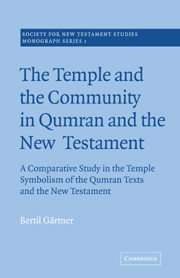 The Temple and the Community in Qumran and the New Testament
The Temple and the Community in Qumran and the New Testament Book contents
- Frontmatter
- Contents
- List of Abbreviations
- Introduction
- AUTHOR'S NOTE
- I The Priesthood and the Jerusalem Temple
- II The Temple Priests and Qumran
- III The ‘New Temple’ in Qumran
- IV Temple Symbolism in the New Testament
- V Temple Symbolism and Christology, Collective and Individual
- Bibliography
- Index of Authors
- Index of Subjects
- Index of Passages Quoted
V - Temple Symbolism and Christology, Collective and Individual
Published online by Cambridge University Press: 26 February 2010
- Frontmatter
- Contents
- List of Abbreviations
- Introduction
- AUTHOR'S NOTE
- I The Priesthood and the Jerusalem Temple
- II The Temple Priests and Qumran
- III The ‘New Temple’ in Qumran
- IV Temple Symbolism in the New Testament
- V Temple Symbolism and Christology, Collective and Individual
- Bibliography
- Index of Authors
- Index of Subjects
- Index of Passages Quoted
Summary
THERE are a number of expressions in the Synoptic Gospels which are of the utmost importance for the expression of Jesus' Messianic consciousness. Prominent among these are the expressions Son of man. Son of God and Son of David. We might also reckon Ebed Tahweh in this group, for although the actual term is relatively unimportant in the Gospels, the Old Testament figure it represents provides a background to a number of sayings of Jesus. These terms express various aspects of the person and calling of Jesus the Messiah. They are consistently used in the synoptic traditions to refer to Jesus and to illustrate his work; they thus apply to an individual. But at the same time these Messianic terms are applied in late Judaism not only to an individual Messianic figure but also to the people of Israel, in which case they refer to a collective. This oscillation and combination of individual and collective is of course typical of the Old Testament and late Judaism. What is interesting in this context is that the Qumran texts make use of parts of the different idea complexes to which these terms belong in order to describe the tasks of the collective community in the last days; they do not use these terms to refer to an individual Messiah.
If we begin with the term Ebed Tahweh and the texts from Deutero-Isaiah, it seems that the ideas they represent were in a number of cases applied to the Qumran community. The Ebed was able to make atonement for sins by his suffering: the Qumran community believed itself, and its individual members, to be called to make atonement for sins.
- Type
- Chapter
- Information
- The Temple and the Community in Qumran and the New TestamentA Comparative Study in the Temple Symbolism of the Qumran Texts and the New Testament, pp. 123 - 142Publisher: Cambridge University PressPrint publication year: 1965


